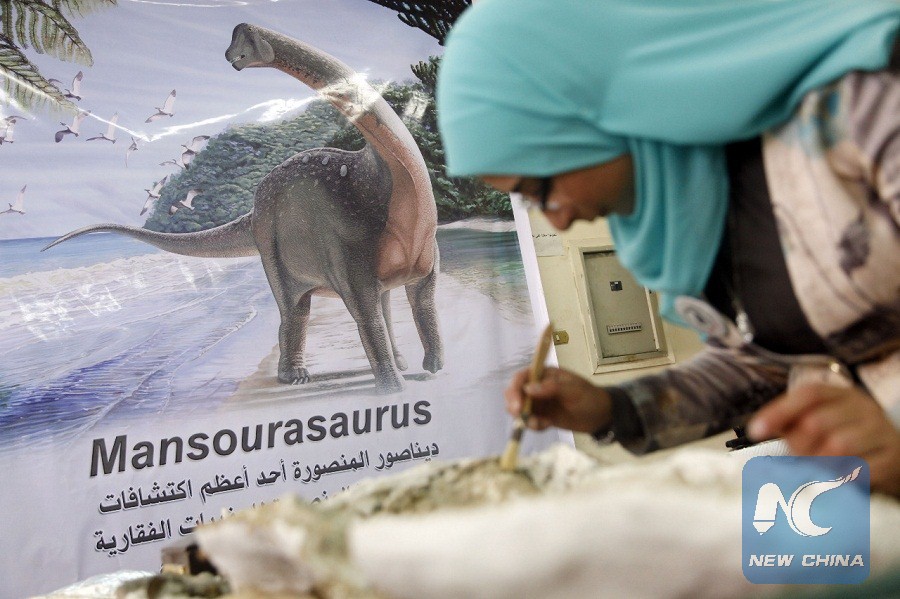
MANSOURA, Egypt, Feb. 7 (Xinhua) -- The Egyptian discovery of remains of an ancient dinosaur in its Western Desert reveals a link between Africa and Europe in the Late Cretaceous Period some 80 million years ago, experts said Wednesday.
It filled in a gap of 30 million years in the history of dinosaurs in Africa, they held.
The discovery was made by a team of Egyptian researchers from Mansoura University's center for Vertebrate Paleontology (MUVP).
The team named the new species Mansourasaurus and the discovery marks a leap in the study of dinosaurs and represents a tangible evidence of the Gondwana split.
The MUVP team consists of the center's chief Hesham Sallam and four female researchers including his deputy Sanaa el-Sayed and researcher Iman el-Dawoudi.
"With our discovery of Mansourasaurus, we cover a missing period of about 30 million years in Africa before dinosaurs died out some 80 million years ago," she said.
"Now we have part of the story about this gap and about the history of dinosaurs in Africa in general after the Gondwana split," Dawoudi told Xinhua at Geology Lab 2 in the MUVP," she added.
"I can say that there is a connection between the dinosaurs living in Africa and those living in Europe during that period," she added.
Displayed on two stretched tables in the spacious lab, the rocky fossils of Mansourasaurus were carefully kept in jackets of gypsum and cloth, and covered with plastic material to keep them well preserved and steady when moved.
"Mansourasaurus is represented by about 65 percent of the discovered elements. We have parts of the jaw, parts of the front limb including the humerus, the radius and the ulna, some carpals and tarsals, in addition to the rips, the sternum, cervical vertebrae, dorsal vertebrae and caudal vertebrae," said the researcher.
She noted that the found parts were sufficient to make a description of the species and compare it with dinosaurs of other continents.
The team said that when they find the right forelimb, it is as if both forelimbs are found because they are identical. Unfortunately, they haven't found any traces of Mansourasaurus back limbs yet.
The team has been working on the big project since 2008 until they found the fossils of Mansourasaurus in the Western Desert's Dakhla Oasis in December 2013 and extracted them in March 2014 after a 21-day desert camping.
Afterwards, they conducted constant studies on Mansourasaurus from 2014 to 2018.
"Mansourasaurus is about five-ton weight and 10-meter length from nose to tail. We can imagine its size as that of an African elephant," Sanaa el-Sayed, MUVP deputy chief and team member, told Xinhua at the center.
She explained that it looked more like those dinosaurs of Europe, "which marks the first tangible evidence of the theory that Africa and Europe were once connected in that period about 80 million years ago."
"Since our finding is new and it resolves a gap in vertebrate paleontology, we contacted world scientific magazine Nature which got it reviewed and assessed by two of the world's top experts in the field before its release last week," said the MUVP senior researcher, who also lectures geology in Mansoura University's Faculty of Science.
Mansourasaurus belongs to a giant type of dinosaurs called Titanosauria, but this one discovered in Egypt is comparatively so small, although the bone studies indicate it was an adult, not a juvenile.
The researchers explained that dinosaurs of that period even in Europe were small and they attributed the reason to possible dwarfism due to scarcity of sufficient resources and land spaces after the Gondwana split.
Since its establishment 10 years ago, the MUVP has been cooperating with several world universities, including those of Ohio and Oxford, as well as other scientific institutions, foundations and museums.
The MUVP team has been honored by Mansoura University chief as well as the country's minister of higher education for their scientific massive effort and accomplishment.
"It is a big scientific discovery in geology that puts Mansoura University on the world map of scientific research," said Mohamed el-Kenawy, president of Mansoura University.
"We have a meeting today with the research team to discuss how to support them for further scientific discoveries. We're also planning to grant them a piece of land to build a museum with international standards and we may communicate with the UNESCO or similar interested world organizations for support," the university chief told Xinhua.
Groups of students of geology in the university occasionally asked permission to get in the lab and take a look at the fossilized skeletal remains of Mansourasaurus and listen to the explanations of the MUVP researchers to understand why it daw worldwide attention.
"We come here because we're curious to learn about the newly discovered dinosaur that got such international attention and coverage, which is an honor for our college, the MUVP and Mansoura University," Kamal Ali, one of the junior students, told Xinhua.

